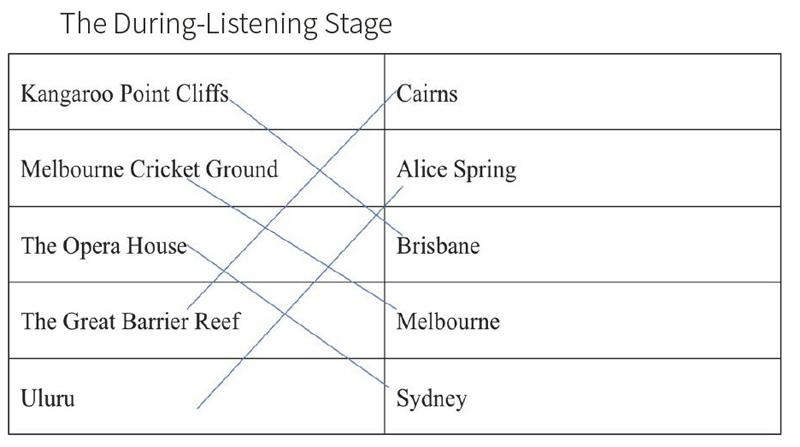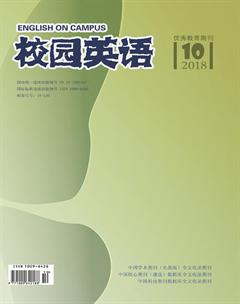Justifying Choices in the Listening Materials

【Abstract】This essay is a reflection on the choices and usage of listening and speaking materials. The essay consists of 5 parts. In the part of Introduction, the author provided readers with supporting ESL theories. At the Pre-Listening Stage, the author introduced a range of activities to have students achieved linguistic and knowledge goals. In the During-Listening, two activities were used. At the Post-Listening Stage, students participated in role-playing to reinforce the use of target language, and in this section, the author also gave out some suggestions on role-play grouping. In a sum, teaching listening can not be separated from teaching speaking.
【Key words】ESL(English as a Second Language); pre-listening; during-listening; post-listening; role-playing; grouping
【作者簡介】杨沁霏,重庆邮电大学移通学院,研究方向:第二语言习得、语言教学。
Introduction
Listening in second language involves quite a complexity. On the one hand, students are involved with linguistic patterns; on the other hand, they are required to have an considerable amount of background knowledge input before achieving the comprehension goals. Cherry(1957, cited in Hedge, 2002, p236) introduced “uncertainties” to view some obstacles in listening comprehension:“language internal elements, e.g. word-sound system and syntax; and the external elements, e.g. contextual meaning and background knowledge, and students need to be prepared with a certain skills or drills before they can achieve the listening outcomes.”Therefore, a well-thought and adaptable teaching plan is need to enhance students comprehension skills, and at the same time, foster their verbal communication.
In the previous listening and speaking designs, twelve intermediate English language learners went through pre-listening, during-listening and post-listening stages in a classroom setting. And in this article, the author will justify the relevant ESL theories behind the choice of activities and materials of each stage.
Enabled Tasks & Real World Tasks, Authentic & Non-Authentic Materials
When choosing a listening task, it is necessary to consider the language accessibility, which should be based on both linguistic and meta-linguistic levels of the learners. The chosen material should give students specific grammatical training and communication purposes. Robinson in Developing Tasks (1996, p57) pointed out “From the task, ESL students are expected to have a certain knowledge in a particular language phenomenon and then the communicative goals.”There are two kinds of tasks: when students are doing real world tasks, they use relevant skills to achieve goals in the world, whereas students usually get the enabled task through a classroom setting, and the latter one aims to develop the skills and knowledge that students need to successfully complete real world tasks.(1996, p57). In reality, the enabled-task training is more likely to be the dominance in a teaching environment. However, it is important for teachers to strive a balance between the two tasks, as both of which are of mutual benefits in developing leaners language competence in a real world.
if an enabled task is designed with a communicative purpose, it can help transfer learning into an authentic situation. Thornbury once mentioned in his work that, “Conversations and dialogues on textbook would make necessarily compromise that scripts could attempt to take into account, and to incorporate, features of naturally occurring spoken language without sacrifice the class-room teaching purpose.”(2008, p44)
The Pre-Listening Stage
At the pre-listening stage, the author prepared students with six steps before having them listened to a holiday script. First, students were orientated to the holiday topic by brainstorm, group discussion, background information activation, and notes-taking. In the section of brainstorm, students were grouped to call out words and phrases, relate their own experience with travel, and even give a brief account of some well-known tourism cities that they had been to. The brainstorm is workable in both whole-classroom and smaller-group settings. (Robinson, p65)
Students were encouraged to note down some key points as well . Note-taking trained students writing speed and spelling accuracy. Robinson (1996, p69-70) suggested a procedure for teachers to use in discussion: first, a common experience must be identified among learners before its related topic is distributed; second, the teacher provides students with sufficient information making sure the topic is clearly defined; third, the teacher reminds students that there would be many answers to one question. Also, the equality of speaking chance for every member in the group is emphasised. At this stage, the role of a teacher is to raise participants interests and awareness, to make learning outcomes explicit and to act as a confidence giver to students performance. By doing this, as Hedge further pointed out (2004, p247),“students would become more confident and are more likely to achieve their learning goal.”
According to the author, not matter an in-class activity is language orientated or background knowledge orientated, the design of each activity should try to involve learners varying language skills and have their previous knowledge activated.
At this stage, first, students listened to the gist which provided them with a big picture of the content; then students could go on to focus on detailed information when listening again. While listening to the gist, students were completing a simple mapping task. And the second time, listening to details, a table was involved to ask students to match each city with its own well-known tourism sites. ( A students match is shown as below.)
Matching is ideal for language learners to connect cities with their tourist sites, and it is also suitable for drills of word collaborations, antonyms and synonyms. In Robinsons task design (1996, p61), he used two columns to help international students gain some Australian English slangs. For example, match “cuppa” with “a cup of tea or coffee”; “chook” means “chick”; and “Gday” is for “Good day” etc. Students learned both language and culture, and some of students might even put slangs they had learned into an authentic conversational context with locals.
The Post-Listening Stage
A careful design at the post-listening stage helps students enhance their receptive skills to a certain productive level. In Gohs Developing lessons From listening tasks, (2002, p29), he listed out four aims for a desired listening class: Practice language skills (speaking, reading, and writing) by using the same theme; examine and reinforce language points (e.g grammar, vocabulary, phrases); personalise contents of the listening material (e.g literary text); acquire further content knowledge.
Role-playing was involved in at the post-listening stage. Role playing in language class allowed students to have scenario-plot creativeness, and students would also try to fit the their dialogues into a real situation. To make students into groups, a teacher needs to realise that, instead of simply establishing a role-play group by interest or friendship, a balanced linguistic levels among individuals, mutual support, and team-member-collaboration must be taken into consideration. Burns and Hood (1997, cited in Chappell, 2009, Topic 11), in a research, indicates that students view mixed-level learning group with a more positive attitude. The disparate group members may also be more genuinely communicative as they draw on individual resources to negotiate meaning with each other (Chappell, 2009, Topic 11).
Conclusion
A well-thought and adaptable plan helps achieve the desired outcomes in a listening (and speaking) class. There are steps to follow: first, use activities that can activate the listeners background knowledge; second, reinforce language patterns that students encounter in the listening text; third, practise the language into a verbal task; fourth, teachers provide timely feedback on students performance.
References:
[1]Robinson,J.&Selman;,M 1996 ‘Developing Task,Partnership in Teaching ESL to Adults,Pippin Publishing,Toronto,pp56-74.
[2]Thornbury,S.2005,How to Teach Speaking,Pearson Education Limited,Essex,England.

